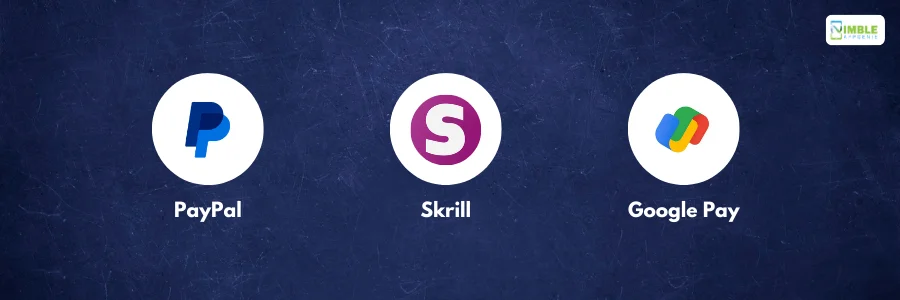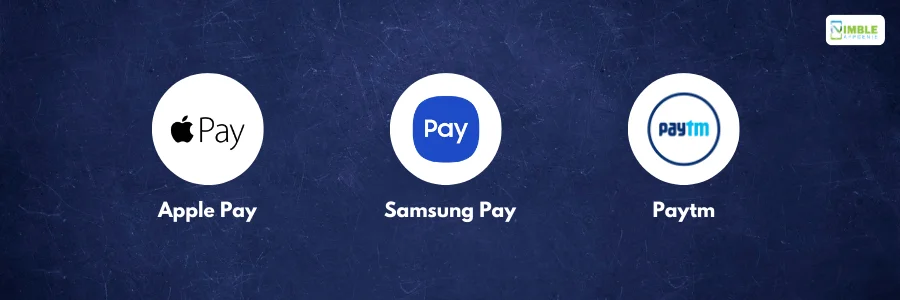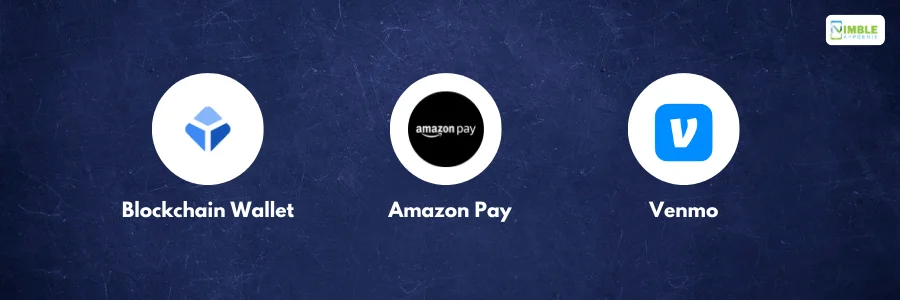eWallet vs Digital Wallet vs Mobile Wallet.
Are they interchangeable? Are the same concepts? Is there any difference between them?
Well, while these three terms sound similar, there are some significant differences between them. And in the age of digital payment where everyone is using one, it’s important to know the difference.
Even more so for investors who want to develop digital payment solutions.
“The future of payments is invisible.” – Marc Andreessen
We have got you covered.
In this blog, we shall be discussing all you need to know about the “mobile wallet vs digital wallet vs eWallet” debate.
Let’s get right into it.
The Growing Industry of Digital Payment
Fintech statistics never fail to show us the huge potential of the market and how much these platforms are making in the industry.
So, before we pry down the difference between mobile wallet, eWallet, and digital payment, let’s dive into the industry.
- The User Base for Digital Payments is Expected to Cross 5,480.00 Million by 2027
- Back in 2020, the market for digital payment as a whole was worth around $4 trillion. Now, boosted by new trends, Statista claims the global market will reach $10 trillion by 2026
- eWallet Statistics shows the market size was around $85.6 Billion in 2022, fast forward to 2023, and it reached 105.5 Billion. If the market follows the same trajectory, it will hit $567.2 Billion by 2032.
- The use of Apps like Apple Pay, Google Pay, & Samsung Pay will double between 2020 and 2025, showing the amazing growth rate of the market and demand for eWallet apps.
- Reports show this solution will be responsible for transactions worth $16 Trillion by 2028.
Now if you want to create a fintech app like Venmo, Cash App, or any other digital payment solution, it is important to know the difference between digital wallet vs mobile wallet vs eWallet. And that’s exactly what we shall be discussing in the section below.
Are Digital Wallet, eWallet, and Mobile Wallet not the same thing?
While the terms “Digital Wallet”, “eWallet”, and “mobile wallet” are used interchangeably, they aren’t the same thing.
So, the answer is, NO, they aren’t the same.
There ever so slight difference between all three of these wallet niches. If you are looking to learn more about it, we shall be discussing just that.
Let’s get started, with the first concept of the eWallet vs digital wallet vs mobile wallet debate:
“The internet has turned commerce inside out.” – Jeff Bezos
What Are eWallet?
Let’s start with the eWallets.
So, what are eWallets? Well, in layman’s terms, these are a digital counterpart of your traditional wallet.
In that sense, it allows the users to store, manage, and transfer digital currency or financial assets.
eWallets can exist in the form of mobile apps, with apps like PayPal being popular examples of the same. No wonder so many companies and startups want to invest in eWallet Software development. Speaking of which, let’s look at some more example below.
eWallet Example

- PayPal: A widely used eWallet that enables online payments and money transfers.
- Skrill: Allows users to make online payments and manage digital currencies.
- Google Pay: While it’s often associated with mobile payments, Google Pay also functions as an eWallet for online transactions.
eWallet Features
Let’s look at some top eWallet features that help you better understand the concept:
- Secure Digital Currency Storage
- Online Transactions
- Payment Method
- Peer-to-Peer Transfers
- Multi-Platform Accessibility
- eWallet security protocols
What Are Mobile Wallets?
Let’s move to the mobile wallet.
This is what you get when you combine digital wallets and mobile app development.
Everything that you get is the same as a digital wallet with the only difference being these are created in the form of mobile applications to be accessible via devices like smartphones and tablets.
This covers various categories of popular solutions like cash advance apps as well as cross-border transaction apps like Transferwise.
A mobile wallet is a type of digital wallet specifically designed for use on mobile devices, such as smartphones or tablets.
Mobile Wallet Example

- Apple Pay: Enables users to make secure and contactless payments using their Apple devices.
- Samsung Pay: A mobile wallet that supports both NFC mobile payments and magnetic secure transmission (MST) for wider compatibility.
- PayTM: The platform is a perfect example of UPI app development done right, gaining the title of mobile wallet super app.
Mobile Wallet Features
To better understand the entire mobile wallet vs digital wallet vs eWallet debate, let’s look at its features.
- Contactless Payments
- Device Compatibility
- Additional Features
- integration with mobile banking services
- Strong App Security
- Offline Payments
What Are Digital Wallets?
Lastly, we have the parent category of both eWallets and mobile wallets.
The concept of “digital wallet” serves as an umbrella term encompassing both eWallets and mobile wallets.
In simple words, any wallet that exists in digital form can be considered a digital wallet.
Consequently, everything from money transfer app development to crypto-wallet app development is covered within this niche.
Digital Wallet Example

- Blockchain Wallet: A digital wallet primarily designed for storing and managing cryptocurrencies like Bitcoin and Ethereum. Leveraging Blockchain development.
- Amazon Pay: While often associated with online shopping, Amazon Pay serves as a digital wallet for making payments on the Amazon platform.
- Venmo: Combining aspects of a social platform with payment functionality, Venmo is a digital wallet for peer-to-peer transactions.
Digital Wallet Features
- Comprehensive Storage
- Security Protocols
- Versatility
- Integration with Services
- Cross-Platform Accessibility
“Money is a terrible idea – not because it’s bad, but because it’s so good. The concept of owning someone something, of exchanging that debt for a good or service, that’s so elegant and complex and nuanced that humans haven’t been able to improve on it for 10,000 years.”
– Elon Musk
eWallet vs Digital Wallet vs Mobile Wallet
Now that you understand the basic concept of all three terms, it’s time to look at how they compare to each other.
In this section of the blog, we shall be doing exactly that.
| Features | Digital Wallet | eWallet | Mobile Wallet |
| Definition | A digital wallet is a software-based system that securely stores users’ payment information and passwords for numerous payment methods and websites. | An eWallet (electronic wallet) is a digital version of a traditional wallet that stores payment card information and facilitates electronic transactions. | A Mobile Wallet is a digital wallet that resides on a mobile device and allows users to store payment information and conduct transactions through a mobile app. |
| Access Platform | can be accessed on various devices, including desktops, laptops, and mobile devices. | Primarily designed for online transactions but can also be accessed on various devices. | Specifically designed for use on mobile devices, such as smartphones and tablets. |
| Usage | can be used for online and offline transactions, both in physical stores and on websites. | Primarily used for online transactions, and in some cases, in-store transactions through QR codes or NFC technology. | Used for in-store and online transactions through mobile devices, often using NFC technology for contactless payments. |
| App Security | Typically secure with features like encryption, biometric authentication, and tokenization. | Security features may vary, but often include encryption and two-factor authentication. | Generally secure with features like biometric authentication, PIN protection, and tokenization. |
| Storage of Payment Methods | can store a variety of payment methods, including credit/debit cards, bank accounts, and cryptocurrency. | Primarily stores credit/debit card information and sometimes supports bank transfers. | Store credit/debit cards and may also support loyalty cards, gift cards, and other payment methods. |
| Usage Scope | Broader usage scope, but not limited to a specific type of transaction or device. | Focused on online transactions, but may support a range of payment methods. | Primarily designed for use on mobile devices and is often used for contactless payments. |
| Integration with Banks | may integrate with banks for direct transfers and account linking. | Some eWallets may have partnerships with banks for services like fund transfers. | Often integrates with banks for direct transfers and account linking. |
| Merchant Acceptance | Widely accepted by various merchants, both online and offline. | Acceptances may vary; widely accepted online and increasingly in physical stores. | Acceptance is growing, especially in regions where mobile payments are popular, but may not be as widespread as other forms. |
| Additional Features | may offer additional features like P2P payments, bill payments, and in-app purchases. | It may have additional features like prepaid cards, international money transfers, and loyalty programs. | It may include features like loyalty card integration, digital ticket storage, and loyalty programs. |
| Regulatory Environment | Subject to various financial regulations depending on the region. | Governed by financial regulations, and compliance may vary globally. | Regulated by financial authorities, and compliance may vary by region. |
Digital Wallet vs eWallet
Let’s start with digital wallet vs eWallet.
So, it goes without saying that both digital wallets and e-wallets are similar terms. Plus, they also share some similarities.
For instance, both store your payment info for easy transactions.
Coming to a difference, digital wallet apps encompass all forms, while e-wallets specifically hold pre-loaded funds for online purchases, money transfers, and even bill payments.
Therefore, you can think of e-wallets as a digital piggy bank that connects to the online world. On the other hand, digital wallets offer broader access using your existing cards.
That’s the basic overview of eWallet vs digital wallet differences.
eWallet vs Mobile Wallet
With all the people who want to create an eWallet app, let’s discuss eWallet vs Mobile wallets.
So, what’s the difference?
While both e-wallets and mobile wallets store payment info for contactless transactions, they take quite different approaches.
Starting with E-wallets, they are like digital piggy banks, holding pre-loaded funds for online shopping, money transfers, or even bills.
For instance, the popular solutions are Venmo or PayPal.
Coming to Mobile wallets, are digital vaults for your existing cards, letting you tap and pay at stores with your phone or smartwatch.
Apple Pay and Google Pay are prime examples.
Both are very similar concepts but with hair-thin differences that separate them. While there is no winner in the mobile wallet vs eWallet debate, they both win in their respective areas.
Also Read Blog: Custodial vs Non-Custodial Wallets
Mobile Wallet vs Digital Wallet
Lastly, we have the mobile wallet vs digital wallet and this one comes with a twist.
Technically, mobile wallets are a type of digital wallet, specifically accessed through a smartphone app.
Imagine a digital wallet family: mobile wallets are the tech-savvy kids who prefer their phones, while other digital wallets (like online or desktop versions) offer broader device options.
So “mobile wallet” narrows down the focus to mobile payment apps like Apple Pay or Google Pay, while “digital wallet” captures the whole payment-storing landscape.
They both make life cashless, but one prefers a smartphone stage!
And that’s the digital wallet vs mobile wallet debate. And with this, we are done with the whole digital wallet vs mobile wallet vs eWallet.
Nimble AppGenie, a Vetted Fintech Solution Development Company Here To Help You
Do you have digital wallet ideas that you want to turn into reality?
Well, whether you want to build an eWallet, digital wallet, or mobile wallet, we have got you covered.
Nimble AppGenie, being a renowned fintech solution development company, is the master of delivering innovation in the form of digital products.
Recognized by platforms like DesignRush, TopDevelopers, GoodFirms, and Clutch. co, we have the right tools and hands-on experience for 700+ projects. Includes:
- Pay By Check– Pay by Check is a popular ewallet mobile app in the United States of America. It allows users to transfer, pay, or even exchange currency.
- SatPay– An eWallet platform is a Versatile eWallet Solution that allows users to request, receive, and send payments without hassle.
- CUT– an E-wallet Mobile App, CUT is available in China and Myanmar. It works well with both RMB and MMK currencies.
- SatBorsa– a Currency Exchange Fintech app. SatBorsa is one of the platforms that is available on both platforms, iOS and Android.
If you want to hire dedicated developers who can convert your idea to reality, we are here to help you.
Conclusion
While the terms “digital wallet,” “eWallet,” and “mobile wallet” are often used interchangeably, they represent distinct concepts in the realm of digital payments. Digital wallets serve as the overarching category, encompassing both eWallets and mobile wallets. E-wallets specifically involve the storage of pre-loaded funds for online transactions, while mobile wallets, a subset of digital wallets, are accessed through smartphone apps for contactless payments using existing cards. Understanding these nuances is crucial, especially for investors and developers venturing into the dynamic and rapidly growing fintech industry.
FAQs
No, they are not the same. Digital Wallet is a broad term that encompasses both eWallets and Mobile Wallets. eWallets are digital versions of traditional wallets that store various forms of digital currency, while Mobile Wallets are specifically designed for use on mobile devices.
Examples of eWallets include PayPal, Skrill, and Google Pay. These platforms allow users to securely store digital currency, make online transactions, and facilitate peer-to-peer transfers.
Mobile Wallet examples include Apple Pay, Samsung Pay, and Venmo. These wallets are designed for mobile devices and often support contactless payments, loyalty card storage, and additional features beyond basic transactions.
The primary difference lies in their design and functionality. eWallets are digital versions of traditional wallets, accessible across various devices, whereas Mobile Wallets are specifically tailored for mobile devices, emphasizing features like contactless payments and optimized user experiences on smartphones or tablets.
No, Digital Wallets encompass a broader category, including eWallets and Mobile Wallets. Examples like Amazon Pay and Venmo demonstrate that digital wallets can be used for various financial transactions beyond cryptocurrencies.
Many eWallets and Digital Wallets are accessible across multiple devices, providing users with cross-platform accessibility. Mobile Wallets are specifically designed for mobile devices but may also offer web interfaces for broader accessibility.
The terms are often used interchangeably, but generally, an online wallet refers to any digital wallet that is accessible over the internet. An e-wallet, short for electronic wallet, is a specific type of digital wallet that stores and manages electronic currency or financial assets.
No, they are not the same. While both are types of digital wallets, a mobile wallet is specifically designed for use on mobile devices like smartphones or tablets, whereas a digital wallet is a broader term encompassing both eWallets and Mobile Wallets.
Mobile money typically refers to a service where users can store and transfer monetary value using a mobile device. A digital wallet, on the other hand, is a broader concept that includes various forms of digital assets, not limited to currency. Mobile wallets can be a type of digital wallet designed for mobile devices.
A digital wallet is an electronic version that stores and manages various forms of digital currency or financial assets electronically. In contrast, a physical wallet is a tangible item used to carry and store items such as cash, credit cards, and identification documents.

Udai Singh is a senior content writer with over 6 years of experience in creating content for FinTech, eWallet, EdTech, and App Development. He is an expert in simplifying complex concepts and creating engaging content that resonates with the audience.
Table of Contents













No Comments
Comments are closed.